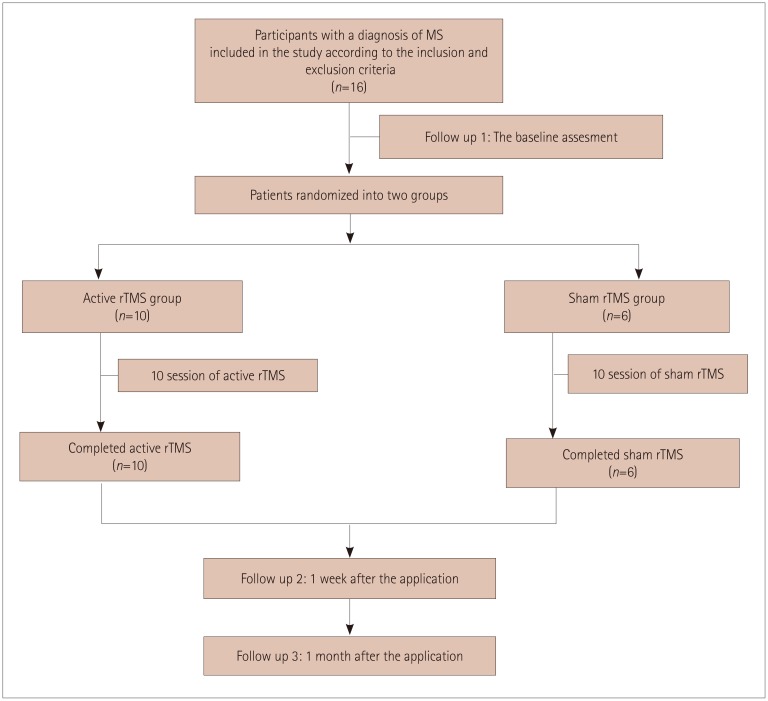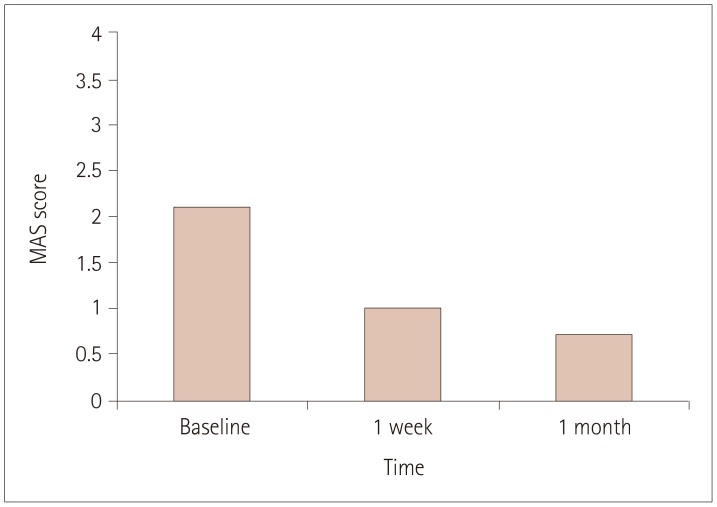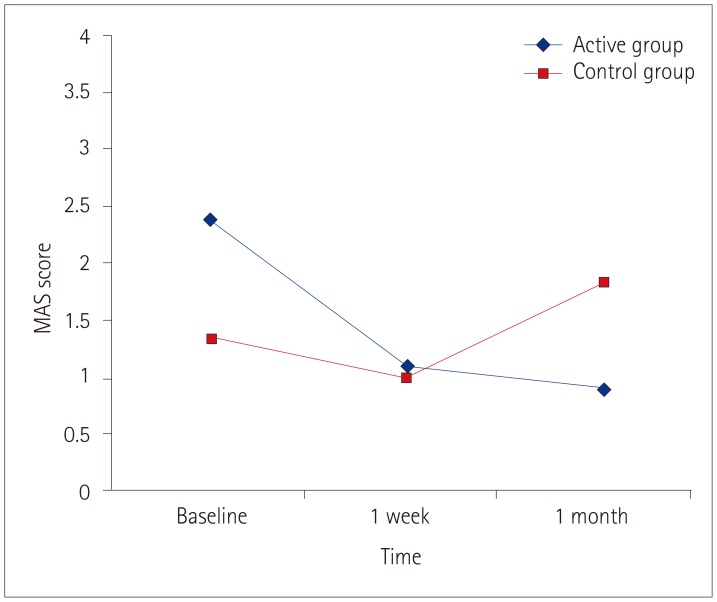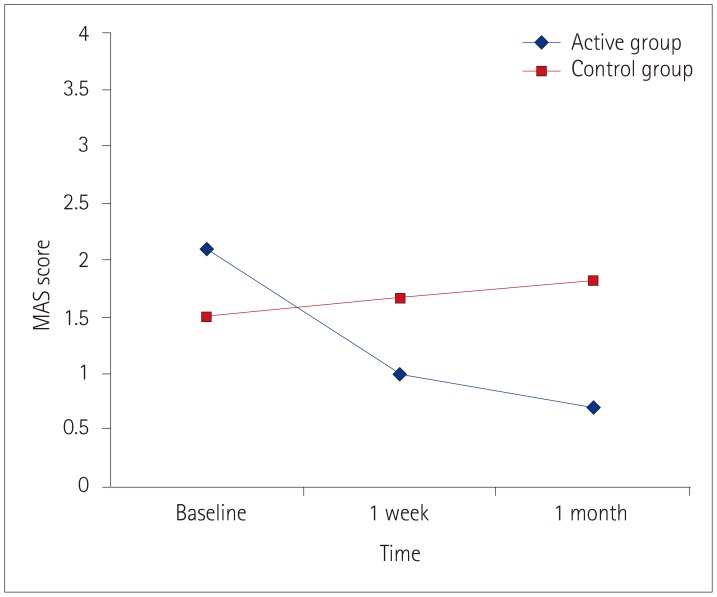J Clin Neurol.
2019 Oct;15(4):461-467. 10.3988/jcn.2019.15.4.461.
The Effect of Repetitive Transcranial Magnetic Stimulation on Spasticity in Patients with Multiple Sclerosis
- Affiliations
-
- 1Department of Physical Rehabilitation Medicine, Karabuk University Karabuk Training and Research Hospital, Karabuk, Turkey. dr.uran@hotmail.com
- 2Department of Physical Rehabilitation Medicine, Health Sciences University, Gulhane School of Medicine, Ankara, Turkey.
- KMID: 2467754
- DOI: http://doi.org/10.3988/jcn.2019.15.4.461
Abstract
- BACKGROUND AND PURPOSE
This randomized controlled study examined the effect of repetitive transcranial magnetic stimulation (rTMS) on spasticity in patients with multiple sclerosis (MS).
METHODS
This study included 16 patients with a history of MS and spasticity in the adductor hip muscles according to the Modified Ashworth Scale (MAS). The participants were randomized into the active group (n=10) and control group (n=6), in which active rTMS and sham rTMS were applied in 10 sessions, respectively. A physical therapy and rehabilitation program was applied along with rTMS sessions in both groups. The evaluation parameters were assessed at baseline and then 1 week and 1 month after applying rTMS.
RESULTS
Statistical analyses with post-hoc correction revealed statistically significant improvements in the active group compared to the control group in the bilateral MAS score, Penn Spasm Frequency Scale score, patient satisfaction, amount of urine leakage, actual health status, perceived health status, energy and fatigue, role limitations due to physical problems, social function, overall quality of life, cognitive functioning, physical health composite score, mental health composite score, and total score on the Multiple Sclerosis Quality of Life-54 (MSQOL-54) (p<0.05). Statistically significant changes were detected in the MSQOL-54 social function and physical health composite scores of patients in the control group (p<0.05).
CONCLUSIONS
Active rTMS combined with a physical therapy program reduced spasticity in MS patients compared to the control group that received only physical therapy. Further comprehensive and more advanced studies are needed to confirm the present findings.
MeSH Terms
Figure
Cited by 1 articles
-
Effectiveness of Non-Pharmacological Interventions for Spasticity Management in Multiple Sclerosis: A Systematic Review
Bhasker Amatya, Fary Khan, Krystal Song, Mary Galea
Ann Rehabil Med. 2024;48(5):305-343. doi: 10.5535/arm.240064.
Reference
-
1. Lassmann H, Brück W, Lucchinetti C. Heterogeneity of multiple sclerosis pathogenesis: implications for diagnosis and therapy. Trends Mol Med. 2001; 7:115–121. PMID: 11286782.
Article2. Karabudak R. Multipl skleroz: bilimsel araştırmalardan tedaviye-multipl sklerozda yeni yönelimler. Hacettepe Tıp Dergisi. 2008; 39:115–120.3. Goldenberg MM. Multiple sclerosis review. P T. 2012; 37:175–184. PMID: 22605909.4. Chwastiak L, Ehde DM, Gibbons LE, Sullivan M, Bowen JD, Kraft GH. Depressive symptoms and severity of illness in multiple sclerosis: epidemiologic study of a large community sample. Am J Psychiatry. 2002; 159:1862–1868. PMID: 12411220.
Article5. Rizzo MA, Hadjimichael OC, Preiningerova J, Vollmer TL. Prevalence and treatment of spasticity reported by multiple sclerosis patients. Mult Scler. 2004; 10:589–595. PMID: 15471378.
Article6. Beard S, Hunn A, Wight J. Treatments for spasticity and pain in multiple sclerosis: a systematic review. Health Technol Assess. 2003; 7:iiiix–x. 1–111.
Article7. Özakbaş S. Multipl Sklerozda Semptomatik Tedavi. Noro Psikiyatr Ars. 2011; 48:83–89.8. Lance JW. Symposium synopsis. In : Feldman RG, Young RR, Koella KP, editors. Spasticity, Disordered Motor Control. Chicago, IL: Year Book Medical Publishers;1980. p. 17–24.9. Richards RG, Sampson FC, Beard SM, Tappenden P. A review of the natural history and epidemiology of multiple sclerosis: implications for resource allocation and health economic models. Health Technol Assess. 2002; 6:1–73.
Article10. Iodice R, Manganelli F, Dubbioso R. The therapeutic use of non-invasive brain stimulation in multiple sclerosis-a review. Restor Neurol Neurosci. 2017; 35:497–509. PMID: 28984619.11. Mori F, Koch G, Foti C, Bernardi G, Centonze D. The use of repetitive transcranial magnetic stimulation (rTMS) for the treatment of spasticity. Prog Brain Res. 2009; 175:429–439. PMID: 19660671.
Article12. Palm U, Ayache SS, Padberg F, Lefaucheur JP. Non-invasive brain stimulation therapy in multiple sclerosis: a review of tDCS, rTMS and ECT results. Brain Stimul. 2014; 7:849–854. PMID: 25359259.13. Centonze D, Koch G, Versace V, Mori F, Rossi S, Brusa L, et al. Repetitive transcranial magnetic stimulation of the motor cortex ameliorates spasticity in multiple sclerosis. Neurology. 2007; 68:1045–1050. PMID: 17389310.
Article14. Rossini PM, Burke D, Chen R, Cohen LG, Daskalakis Z, Di Iorio R, et al. Non-invasive electrical and magnetic stimulation of the brain, spinal cord, roots and peripheral nerves: basic principles and procedures for routine clinical and research application. An updated report from an I.F.C.N. Committee. Clin Neurophysiol. 2015; 126:1071–1107. PMID: 25797650.
Article15. Centonze D, Petta F, Versace V, Rossi S, Torelli F, Prosperetti C, et al. Effects of motor cortex rTMS on lower urinary tract dysfunction in multiple sclerosis. Mult Scler. 2007; 13:269–271. PMID: 17439897.
Article16. Ozakbas S, Cagiran I, Ormeci B, Idiman E. Correlations between multiple sclerosis functional composite, expanded disability status scale and health-related quality of life during and after treatment of relapses in patients with multiple sclerosis. J Neurol Sci. 2004; 218:3–7. PMID: 14759626.
Article17. Kurtzke JF. Rating neurologic impairment in multiple sclerosis: an expanded disability status scale (EDSS). Neurology. 1983; 33:1444–1452. PMID: 6685237.
Article18. Patzold T, Schwengelbeck M, Ossege LM, Malin JP, Sindern E. Changes of the MS functional composite and EDSS during and after treatment of relapses with methylprednisolone in patients with multiple sclerosis. Acta Neurol Scand. 2002; 105:164–168. PMID: 11886358.
Article19. Heiskanen S, Meriläinen P, Pietilä AM. Health-related quality of life-testing the reliability of the MSQOL-54 instrument among MS patients. Scand J Caring Sci. 2007; 21:199–206. PMID: 17559438.20. Read DJ, Matthews WB, Higson RH. The effect of spinal cord stimulation on function in patients with multiple sclerosis. Brain. 1980; 103:803–833. PMID: 7437891.21. Hallett M. Transcranial magnetic stimulation and the human brain. Nature. 2000; 406:147–150. PMID: 10910346.
Article22. Rossi S, Hallett M, Rossini PM, Pascual-Leone A;. Safety, ethical considerations, and application guidelines for the use of transcranial magnetic stimulation in clinical practice and research. Clin Neurophysiol. 2009; 120:2008–2039. PMID: 19833552.
Article23. Siebner HR, Rothwell J. Transcranial magnetic stimulation: new insights into representational cortical plasticity. Exp Brain Res. 2003; 148:1–16. PMID: 12478392.
Article24. Nielsen JF, Sinkjaer T, Jakobsen J. Treatment of spasticity with repetitive magnetic stimulation; a double-blind placebo-controlled study. Mult Scler. 1996; 2:227–232. PMID: 9050361.
Article25. Kumru H, Murillo N, Samso JV, Valls-Sole J, Edwards D, Pelayo R, et al. Reduction of spasticity with repetitive transcranial magnetic stimulation in patients with spinal cord injury. Neurorehabil Neural Repair. 2010; 24:435–441. PMID: 20053952.
Article26. Gupta M, Lal Rajak B, Bhatia D, Mukherjee A. Effect of r-TMS over standard therapy in decreasing muscle tone of spastic cerebral palsy patients. J Med Eng Technol. 2016; 40:210–216. PMID: 27010377.
Article27. Málly J, Dinya E. Recovery of motor disability and spasticity in post-stroke after repetitive transcranial magnetic stimulation (rTMS). Brain Res Bull. 2008; 76:388–395. PMID: 18502315.
Article28. Mori F, Ljoka C, Magni E, Codecà C, Kusayanagi H, Monteleone F, et al. Transcranial magnetic stimulation primes the effects of exercise therapy in multiple sclerosis. J Neurol. 2011; 258:1281–1287. PMID: 21286740.
Article29. Iodice R, Dubbioso R, Ruggiero L, Santoro L, Manganelli F. Anodal transcranial direct current stimulation of motor cortex does not ameliorate spasticity in multiple sclerosis. Restor Neurol Neurosci. 2015; 33:487–492. PMID: 26409407.30. Nielsen JF, Klemar B, Hansen HJ, Sinkjaer T. A new treatment of spasticity with repetitive magnetic stimulation in multiple sclerosis. J Neurol Neurosurg Psychiatry. 1995; 58:254–255.
Article
- Full Text Links
- Actions
-
Cited
- CITED
-
- Close
- Share
- Similar articles
-
- Application of Non-invasive Brain Stimulation on Dysphagia after Stroke
- The Effect of High Frequency Repetitive Transcranial Magnetic Stimulation on the Motor Function in Post-Stroke Patients
- Effectiveness of Non-Pharmacological Interventions for Spasticity Management in Multiple Sclerosis: A Systematic Review
- Repetitive Transcranial Magnetic Stimulation for Limb-Kinetic Apraxia in Parkinson's Disease
- Predictors of Response to Repetitive Transcranial Magnetic Stimulation in Depression: A Review of Recent Updates






